Dress up your code with a beautiful graphical user interface !
Project description
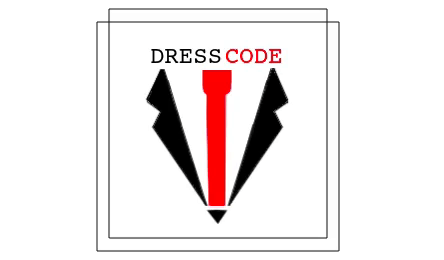
Dresscode
Dress up your code with a beautiful graphical user interface !
This project is part of the Pyrustic Ecosystem. Look powered by the cyberpunk theme.
Showcase | Installation | Usage | Tutorial | Reference
Showcase
Welcome ! Let me show you something:
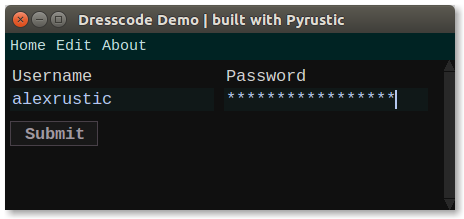
Figure 1 - Demo
What if I told you that I did this with 1 Hex-digit lines of code :tm: ?
The menu bar in Figure 1 is not a gimmick. Clicking on the buttons in the menu bar opens another page. So in fact I showed only 1/3 of the pages !
Let's take a look at the other pages:
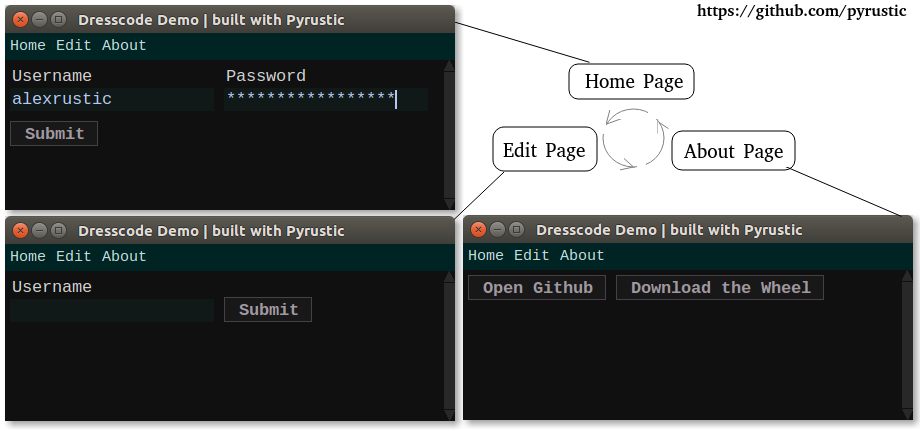
Figure 2 - 1 hex-digit lines of code generated an app with 3 pages !
Now you are wondering how I did this with just 1 hex-digit lines of code :tm:.
Well, I first defined the first page:
from dresscode import page
home_page = page.Page(pid="home", name="Home")
home_page.add_entry(title="Username")
home_page.add_entry(title="Password", secretive=True)
home_page.add_button(new_row=True)
Then I defined the second page:
from dresscode import page
edit_page = page.Page(pid="edit", name="Edit")
edit_page.add_entry(title="Username")
edit_page.add_button(on_click=lambda page, cid: page.show_toast("Hello"))
Then the third page:
from dresscode import page
about_page = page.Page(pid="about", name="About")
about_page.add_button(text="Open Github")
about_page.add_button(text="Download the Wheel")
And then I created the app and linked the three pages to it.
from dresscode import app, page
...
my_app = app.App(title="Dresscode Demo", width=450, height=150, home="home")
my_app.add_page(home_page)
my_app.add_page(edit_page)
my_app.add_page(about_page)
my_app.start()
The 1 hex-digit lines of code:
from dresscode import app, page
my_app = app.App(title="Dresscode Demo", width=450, height=150, home="home")
home_page = page.Page(pid="home", name="Home")
home_page.add_entry(title="Username")
home_page.add_entry(title="Password", secretive=True)
home_page.add_button(new_row=True)
edit_page = page.Page(pid="edit", name="Edit")
edit_page.add_entry(title="Username")
edit_page.add_button(on_click=lambda page, cid: page.show_toast("Hello"))
about_page = page.Page(pid="about", name="About")
about_page.add_button(text="Open Github")
about_page.add_button(text="Download the Wheel")
my_app.add_page(home_page)
my_app.add_page(edit_page)
my_app.add_page(about_page)
my_app.start()
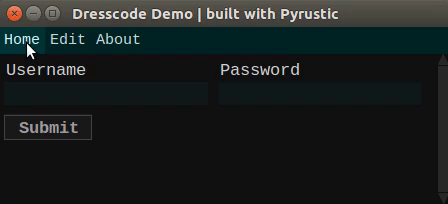
Figure 3 - Demo Animation
Voilà !
This is the full source code with comment and well structured:
from dresscode.app import App
from dresscode.page import Page
def get_home_page():
# defining the home page here
page = Page(pid="home", name="Home") # pid = page id !
page.add_entry(title="Username")
page.add_entry(title="Password", secretive=True) # secret secret !
page.add_button(new_row=True)
return page
def get_edit_page():
page = Page(pid="edit", name="Edit")
page.add_entry(title="Username")
# Clicking this button will pop up a "Hello"
page.add_button(on_click=lambda page, cid: page.show_toast("Hello"))
return page
def get_about_page():
page = Page(pid="about", name="About")
page.add_button(text="Open Github")
page.add_button(text="Download the Wheel")
return page
# the home argument is the pid of the page to show at start up
app = App(title="Dresscode Demo", width=450, height=150, home="home")
# adding pages to the app !
app.add_page(get_home_page())
app.add_page(get_edit_page())
app.add_page(get_about_page())
# lift up !
app.start() # the mainloop is hidden here ! ;)
Basically, you can just pip install dresscode, open a lightweight code editor, copy, paste, run the code and yeah it should work ! Try it !
Wondering what will happen when there are 10 pages ? Yes your menu bar will be full. The solution: buy large screens !
Joking aside, here's the solution:
...
# Asking Dresscode to create a dropdown menu 'Menu'
# then stack inside it the references to the pages !
app.add_page(home_page, category="Menu")
app.add_page(edit_page, category="Menu")
app.add_page(about_page, category="Menu")
...
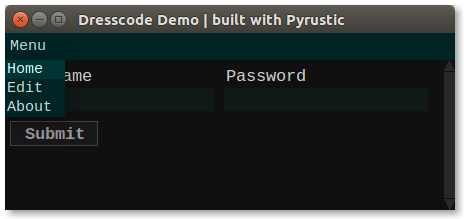
Figure 4 - No need to buy large screens !
Installation
pip install dresscode --upgrade --upgrade-strategy eager
Interaction with Dresscode
Dress up your code with a beautiful graphical user interface ! was the intro to this README. There is a clear distinction between the backend and the frontend. The question that arises is therefore how to communicate the frontend and the backend.
With Dresscode, you can specify when creating a component which handler to call when a particular event occurs.
With the button component, there are the on_click parameter to keep a reference to the event handler. So basically, you just need to have a handler with 2 parameters: page and cid.
from dresscode.app import App
from dresscode.page import Page
def handler(page, cid):
"""
page: the page object
cid: the component id (here, the button cid)
"""
# say 'Hello' !
page.show_toast("Hello component {}".format(cid))
# you can inspect the dict of components (keys are cid)
components = page.components # be curious, inspect the dict !
# you can retrieve the data from a component
username = page.get_data("username")
# or you can display a large text
page.show_text("Helloo\n{}".format(username), title="My large text")
# or, ask for a confirmation
ok = page.ask_confirmation() # blocks the app, returns a boolean
# you can even decide to scroll the content of the page
page.scroll(value=1.0)
# you can add a new page at runtime !!!
app = page.app
app.add_page(Page(pid="new_page", name="New"))
# and guess what, you can open this new page !
app.open_page("new_page")
# and if you are in a hurry to open the home page
app.open_home()
def get_home_page():
# home page - a pid will be generated automatically if you don't set it
page = Page(pid="home", name="Home")
page.add_entry(cid="username", title="Username")
# if you don't set a cid, it will be generated
page.add_button(on_click=handler) # a cid will be generated automatically
# Note, if you click the button twice, you will get a:
# dresscode.exception.DresscodeException
# Duplicate page id isn't allowed (new_page) !
# Guess why ! This isn't a bug but a feature ! hahaha !
return page
app = App(title="Dresscode Demo", width=450, height=150, home="home")
app.add_page(get_home_page())
# lift up !
app.start()
Components
Do you think Dresscode only offers two components, the input field and the button ?
Normally that would be enough. But I implemented a multitude of components to allow everyone to build applications quickly, from the simplest to the most complex.
Checkbuttons
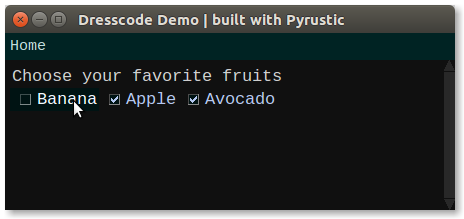
Figure 5 - Checkbuttons
from dresscode.app import App
from dresscode.page import Page
def get_home_page():
page = Page(pid="home", name="Home")
items = ("Banana", "Apple", "Avocado")
page.add_checkbutton(title="Choose your favorite fruits", items=items)
# you could add a on_choice event handler ;)
return page
app = App(title="Dresscode Demo", width=450, height=150, home="home")
app.add_page(get_home_page())
# lift up !
app.start()
Dropdown list
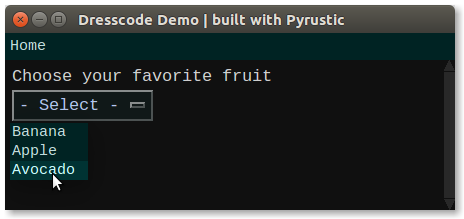
Figure 6 - Drop-down list
from dresscode.app import App
from dresscode.page import Page
def get_home_page():
page = Page(pid="home", name="Home")
items = ("Banana", "Apple", "Avocado")
page.add_dropdown_list(title="Choose your favorite fruit", items=items)
# you could add a on_choice event handler ;)
return page
app = App(title="Dresscode Demo", width=450, height=150, home="home")
app.add_page(get_home_page())
# lift up !
app.start()
Editor
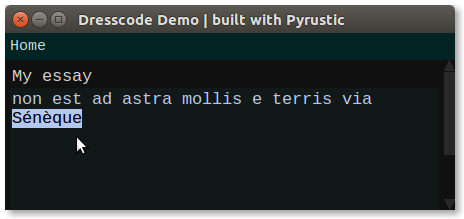
Figure 7 - Editor
from dresscode.app import App
from dresscode.page import Page
def get_home_page():
page = Page(pid="home", name="Home")
essay = "non est ad astra mollis e terris via\nSénèque"
page.add_editor(title="My essay", text=essay, readonly=True)
# you could change the width and or height...
return page
app = App(title="Dresscode Demo", width=450, height=150, home="home")
app.add_page(get_home_page())
# lift up !
app.start()
Label
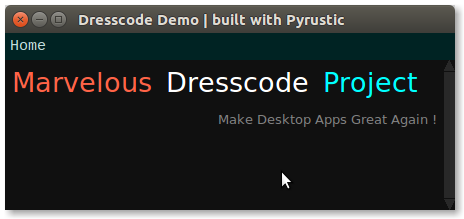
Figure 8 - Label
from dresscode.app import App
from dresscode.page import Page
def get_home_page():
page = Page(pid="home", name="Home")
page.add_label(text="Marvelous")
page.add_label(text="Dresscode", color="white")
page.add_label(text="Project", color="cyan")
text = "Make Desktop Apps Great Again !"
page.add_label(new_row=True, text=text, color="gray",
side="right",
font=("Corrier", 10))
return page
app = App(title="Dresscode Demo", width=450, height=150, home="home")
app.add_page(get_home_page())
# lift up !
app.start()
Radiobuttons
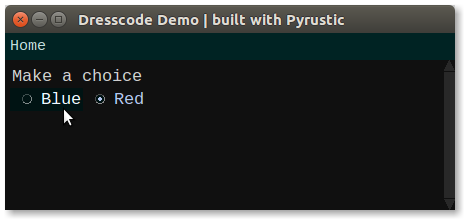
Figure 9 - Radiobuttons
from dresscode.app import App
from dresscode.page import Page
def get_home_page():
page = Page(pid="home", name="Home")
items = ("Blue", "Red")
page.add_radiobutton(title="Make a choice", items=items)
return page
app = App(title="Dresscode Demo", width=450, height=150, home="home")
app.add_page(get_home_page())
# lift up !
app.start()
Space
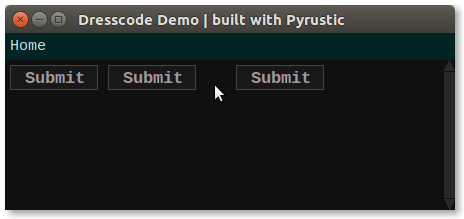
Figure 10 - SpaceX
from dresscode.app import App
from dresscode.page import Page
def get_home_page():
page = Page(pid="home", name="Home")
items = ("Blue", "Red")
page.add_button()
page.add_button()
page.add_space() # you can alter the width, height and more...
page.add_button()
return page
app = App(title="Dresscode Demo", width=450, height=150, home="home")
app.add_page(get_home_page())
# lift up !
app.start()
Spinbox
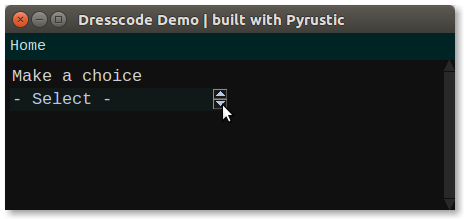
Figure 11 - Spinbox
from dresscode.app import App
from dresscode.page import Page
def get_home_page():
page = Page(pid="home", name="Home")
items = ("Blue", "Red")
page.add_spinbox(title="Make a choice", items=items)
return page
app = App(title="Dresscode Demo", width=450, height=150, home="home")
app.add_page(get_home_page())
# lift up !
app.start()
path entry
The path entry is part of pyrustic.widget. Discover the Pyrustic framework !
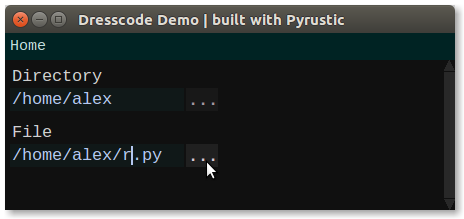
Figure 12 - Pathentry
from dresscode.app import App
from dresscode.page import Page
def get_home_page():
page = Page(pid="home", name="Home")
page.add_path_entry(title="Directory", browse="dir")
page.add_path_entry(new_row=True, title="File")
return page
app = App(title="Dresscode Demo", width=450, height=150, home="home")
app.add_page(get_home_page())
# lift up !
app.start()
Table
The table is part of pyrustic.widget. Discover the Pyrustic framework !
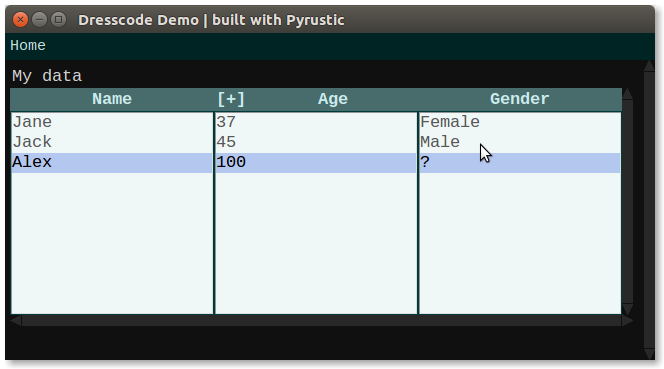
Figure 13 - Table
from dresscode.app import App
from dresscode.page import Page
def get_home_page():
page = Page(pid="home", name="Home")
columns = ("Name", "Age", "Gender")
data = [("Jack", 45, "Male"), ("Jane", 37, "Female"), ("Alex", 100, "?")]
page.add_table(title="My data", columns=columns, data=data)
return page
app = App(title="Dresscode Demo", width=650, height=300, home="home")
app.add_page(get_home_page())
# lift up !
app.start()
Image
Admit that you didn't expect this !
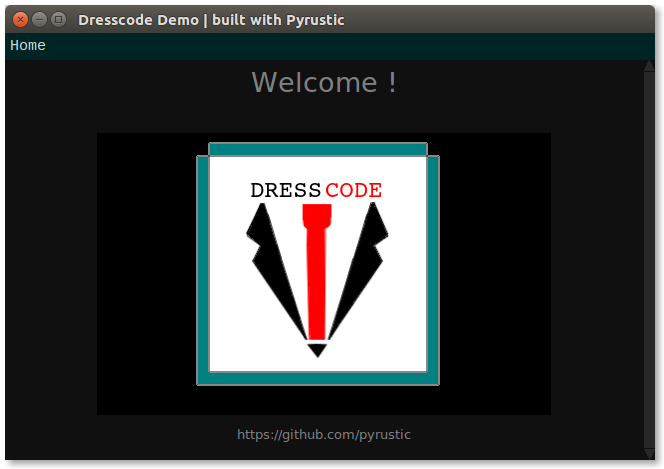
Figure 14 - Image
from dresscode.app import App
from dresscode.page import Page
def get_home_page():
page = Page(pid="home", name="Home")
page.add_label(text="Welcome !", side=None, anchor="center", color="gray")
with open("/home/alex/dresscode.png", "rb") as file:
image = file.read()
# to center any component, the trick: side=None, anchor="center" !
page.add_image(new_row=True, image=image, side=None, anchor="center")
page.add_label(text="https://github.com/pyrustic", side=None, anchor="center",
font=("Courrier", 10), new_row=True, color="gray")
return page
app = App(title="Dresscode Demo", width=650, height=400, home="home")
app.add_page(get_home_page())
# lift up !
app.start()
Cherry on the cake
Since we have this rebellious little side to wanting to customize everything, I implemented the possibility of adding custom components !
from dresscode.app import App
from dresscode.page import Page
# I will cover this topic another time !
def data_getter(page, cid):
data = None
return data
def builder(page, cid):
parts = {}
return parts, data_getter
def get_home_page():
page = Page(pid="home", name="Home")
page.add_custom(builder=builder)
return page
app = App(title="Dresscode Demo", width=650, height=400, home="home")
app.add_page(get_home_page())
# lift up !
app.start()
There you go, so I won't be asked to add new components ! :)
Epilog
I created a Discord for announcements and discussions etc. Join the Discord !
Work in progress...
Project details
Download files
Download the file for your platform. If you're not sure which to choose, learn more about installing packages.
Source Distribution
Built Distribution
Hashes for dresscode-0.0.2-py3-none-any.whl
| Algorithm | Hash digest | |
|---|---|---|
| SHA256 | 43b94cdf163aca87badd579412ef6d906442c58afb263965f1baae00eafc4460 |
|
| MD5 | 3bf005f1518b2debec5d50c5bd9f1f76 |
|
| BLAKE2b-256 | 51f26ad478b25d1fda0f24253216193e06876bb2f2536b74a37494ec202e2f45 |











